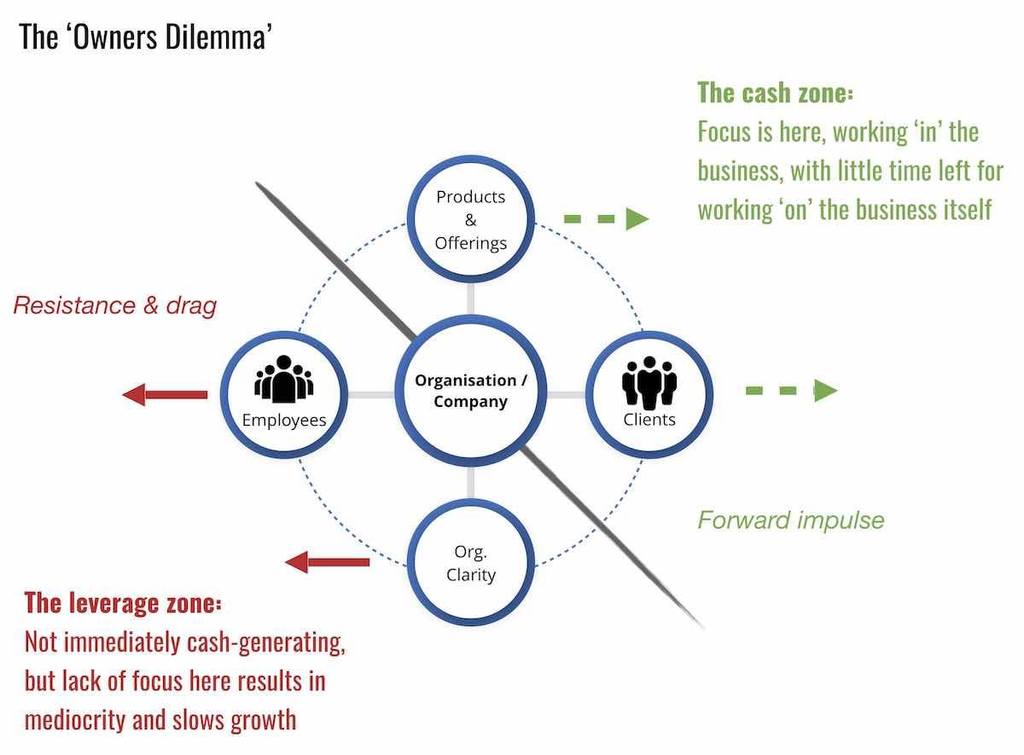Remember Clayton Christensen’s classic, The Innovator’s Dilemma? It was the brilliant observation of how well-managed market leaders would almost invariably fall prey to disruptive technology, and fail to capture the next wave of value.
What was startling about Christensen’s work was that the incumbent firms were well-managed and made rational decisions at each stage of the market’s development. Yet still they lost.
Today I want to explore what could be called The Owner’s Dilemma.
I’m going to explain why the pragmatic, rational decisions you are making are undermining your business’s ability to grow.
If you are a founder, a small business leader, or a business unit leader (i.e. you have ‘ownership’ of a P&L) then this will be highly relevant.
The two top priorities of every business owner
Let’s picture the typical situation in most businesses:
You have limited resources. You are pushing for growth. Everyone is rushed off their feet. Cash flow is constantly top-of-mind. As the owner, you are focused on the twin drivers of revenue: products and customers. If it doesn’t improve the product or doesn’t win a customer, it’s not a priority.
Your laser focus is necessary. It’s admirable. It’s the right thing. And yet, in powerful but unseen ways it’s actually slowing your business down.
It’s that the twin focus on product and customer has excluded any meaningful investment in the foundations of the business.
The two essential foundations that easily get overlooked
These hidden foundations?
- Firstly, people. Because it’s people who build the product. It’s people who close the deals. It’s people who serve the customers.
- Secondly, organisational clarity. Because people operate in the context of the larger organisation. So to contribute at their highest potential they need a shared view of what long-term success looks like, how decisions should be made, how the organisation should function and what ‘getting to the next level’ looks like.

But instead, almost all the attention remains on the ‘cash zone’. So what typically happens? Something like this:
Your employees aren’t receiving the intentional investment to grow in the areas that are holding them back. Some people are growing, but it’s accidental and unplanned, and other people have stagnated. As a result, everyone is maxed out, especially you.
The organisation is like a car that’s long overdue a service. There are misalignments ‘in the system’ that require constant time, energy and attention to correct. Sometimes these manifest as relationship issues and disputes, sometimes as wasted work cycles and lack of teamwork, sometimes as failure to execute.
Your “team” feels more like a collection of individuals. Team meetings are mediocre, with some people barely contributing and others dominating the discussion. You feel certain issues aren’t being put on the table. You spend most of the agenda fighting fires rather than making the big bold decisions that will move the needle.
And so forth.
A problem so pervasive, it almost feels normal
This lack of attention to the underpinnings of the business is a major recurring issue in businesses around the world. So much so that we can think there is no other way.
And the results?
- Only 13% of employees are actively engaged at work (Gallup research); and
- 24% are so disengaged they are likely to spread negativity to others.
- 86% of business leaders have an inadequate leadership pipeline (Deloitte);
- 79% of business leaders have a significant retention and engagement problem; and
- 75% are struggling to attract and recruit the top people they need.
In 2001, Douglas Conant become CEO of the Campbell Soup Co., which was seen – in the words of one magazine – as “a beleaguered old brand.” Sales were way down. Conant took what others called a “poor” company and lifted its performance to incredible heights. One of his secrets? Employee engagement.
“To win in the marketplace we believe you must first win in the workplace. I’m obsessed with keeping employee engagement front and center and keeping up energy around it.” ~ Douglas Conant
Your saw is blunt
A long time ago, Steven Covey coined the phrase “Sharpen the Saw” as the seventh “habit of highly effective people”.
The analogy was of a woodsman cutting down trees: you actually achieve more and cut down trees a lot faster if you take time now and again to stop the “actual work” of sawing and sharpen the saw instead. Without an intentional personal programme of restoration and growth, Covey argued, our personal effectiveness soon maxes out.
What we’re discussing here is the corporate equivalent of Covey’s illustration:
- The “sawing” is the cash zone: of acquiring and serving customers and of building great products.
- The “sharpening the saw” is the leverage zone: clarifying the organisation set-up and growing the capacity and capabilities of the team members.
Putting it another way, the “cash zone” of products and customers is the urgent and important tactical work. But the “leverage zone” of employee growth and organisational clarity is the important but non-urgent strategic work that so often gets sidelined.
A quick check
How much attention are you giving to each of these activities?
- Allocate 10 points across the four categories below, reflecting how much attention you give each area.
- Then allocate another 10 points across each category reflecting the balance you aspire to achieve.
Customers: Identifying prospects and acquiring new customers and channel partners. Managing the sales pipeline. Serving go-to-market partners and customers and dealing with support issues.
Products: Developing value propositions, building product and service roadmaps and addressing quality or feature issues. Working on the product itself. Dealing with suppliers and partners.
Employees: Developing internal leadership capability and skills transfer. Ensuring the team is functioning at its highest potential. Ensuring the right person is in the right role. Creating an environment that retains the best talent. Building alignment and motivation.
Organisation: Providing clarity on the overarching mission and vision of the organisation. Embedding a clear set of decision-making criteria to align the whole team. Making sure everyone knows how they contribute to achieving the big goals the business has set for itself. Ensuring people, resources and capital are properly allocated to the highest-returning opportunities.
So – how did you score?
[one_third_first]Customers
Products
Employees
Organisation
Total[/one_third_first][one_third]__/10
__/10
__/10
__/10
10/10[/one_third][one_third_last] [/one_third_last]
What do you notice about your scores? Where are you over-investing and where do you need to apply more intentionality and focus?
In a future article we’ll look at some practical ways to restore the balance.


